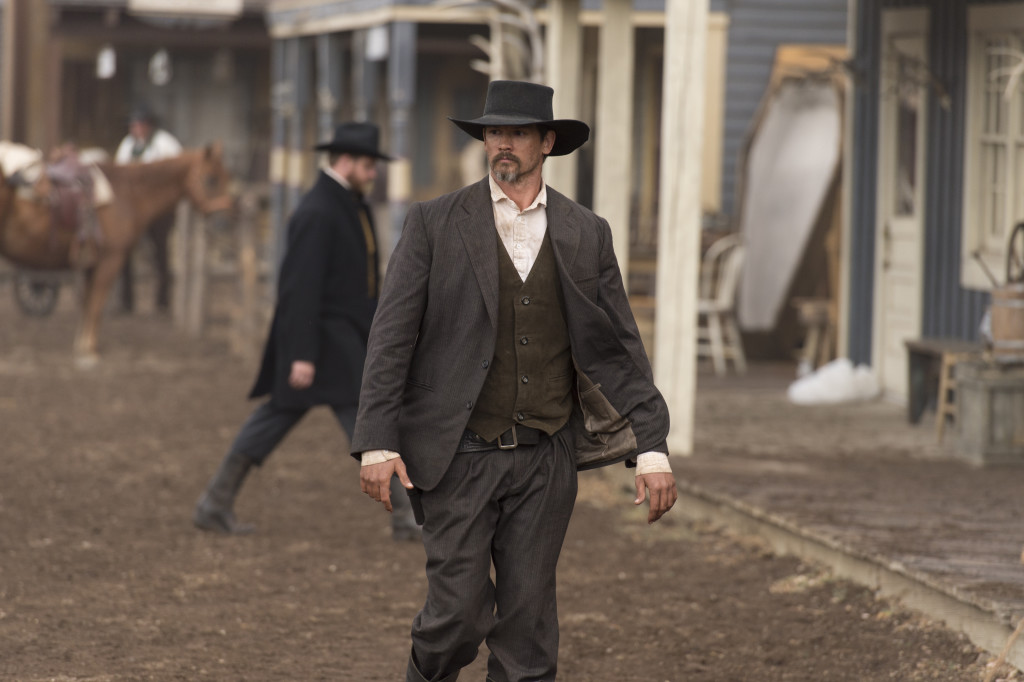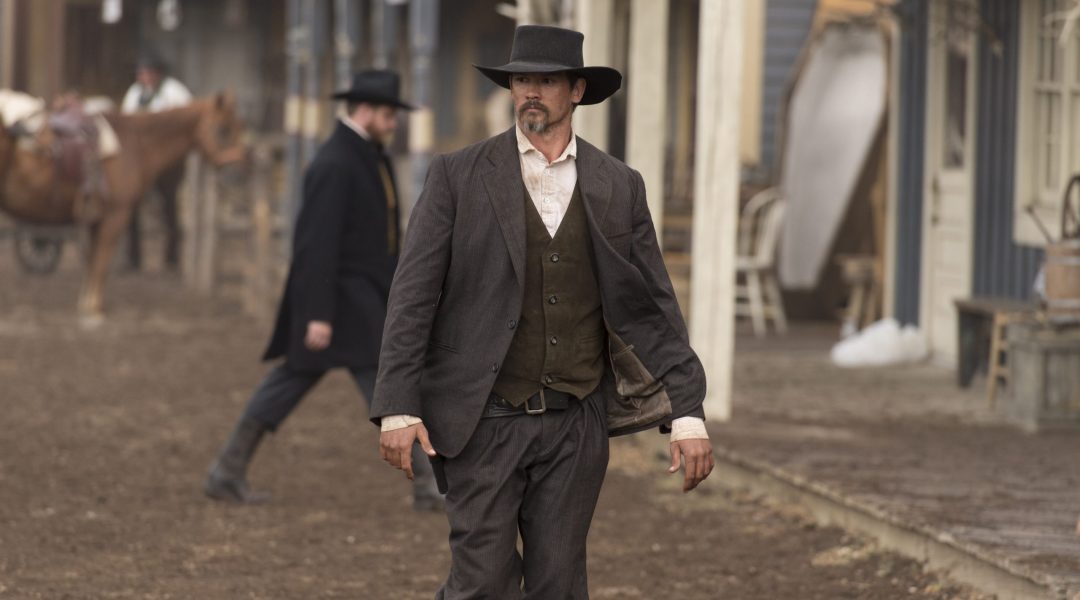
The Texas-born actor plays legendary lawman Pat Garrett.
Notables as diverse as James Coburn, Thomas Mitchell, and Barry Sullivan may have beaten him to the draw, but Ric Maddox thinks he can put his own personal stamp on Wild West icon Pat Garrett. The Texas-born actor plays the legendary lawman known best for killing Billy the Kid in The American West, the limited-run dramatic documentary series now airing on the AMC cable network.
Long before he was cast as Garrett, Maddox earned his spurs while growing up on the family ranch in Pleasanton, Texas, where he learned to rope and ride under the watchful eye of his father, Richard Calvin Maddox, a cowboy and competitive team roper. More important, he demonstrated his capacity for real-life heroics during his tour of duty with the U.S. Army in Iraq, serving as an Alpha Team Leader in the 1st Battalion 8th Infantry Regiment — and earning five Army Achievement Medals and the prestigious Expert Infantry Badge.
Upon returning from Iraq, Maddox fortuitously landed a small role in The Alamo, the 2004 epic that director John Lee Hancock filmed on location in Texas, and the acting bug bit hard. He trained for three years at the Stella Adler Studio in New York, landed supporting roles in other films and TV productions, and earned the Best Supporting Actor award at the 2013 Playhouse West Film Festival for his performance in the dramatic short Black Irish. On Saturday, July 15, he starts his three-episode arc as Pat Garrett in The American West. But that drama, he told us during a recent telephone interview, won’t end his association with western roles.
Cowboys & Indians: The American West is a dramatic documentary, meaning that the project mixes dramatic scenes, archival material, and talking-heads interviews. Did that place unique demands on you and the rest of the cast?
Ric Maddox: I think for us, it was pretty straightforward in the sense that we’re being filmed, and we’re just living out the scene. Knowing that there’s going to be interviews and this and that — they didn’t direct us like that. Now, the audition really was unique, in the sense that [director] John Ealer and I did it all over Skype. Which was interesting, because I never went in and met him — it was just over a Skype session. We worked together for a good 20, 30 minutes. He threw me some different lines, and I just picked them up and did them. And he had me go super emotional, and then a little harder. I think he was just testing to see if I could take direction.
And I wore the whole cowboy get-up. I had my Wyatt Earp mustache, my real one, grown out. I had my hair like Garrett’s. I put on a cowboy vest. And, yeah, I told him I could ride horses, I could really ride horses.
C&I: That very likely sealed the deal for you.
Maddox: They took advantage of that when we were actually on location [in Utah]. They took had a B-unit shoot a lot of riding footage with me. And that was nice, that was probably my favorite part of the whole thing — doing these hard gallops and having the 80-foot crane next you, maybe just 10 feet or 5 feet away from your face.
C&I: What was the most challenging aspect of playing Pat Garrett?
Maddox: I would say the most challenging thing for me was definitely getting the horse to move close to the camera sometimes, because these horses weren't movie horses. These were ranch horses. You had to know a little bit about what you were doing with them, because they would go all over the place. If you give them their reins, they'll go wherever they want. You had to have a strong hand with them, especially the one they gave me. The one they gave me was a stallion for 10 years.
See, the wrangler on the show, she was a spitfire of a little cowgirl. She came up, she looked me in the eye — and she gave me a palomino with an English saddle. I looked at her and I was like, “OK. All right. I see where you’re going with this. You want to see what I can do.” So I swung up and I got on the English saddle. She asked me to post trot and do figure-eights and canter and stop and left and right and all that stuff. Afterwards, she didn’t tell me if I did good or not. But she gave me the strongest horse on the set, for sure. She handed me the reins and said, “He was a stallion for 10 years, but you’re the only guy I’ve got here that can handle him. I got the bit set a little tight. He’s going to want to run off on you. I’m just letting you know.”
C&I: So how did the two of you — well, bond?
Maddox: Slowly. [Laughs.] There was this day on location when John said, “OK, Ric, we want you to stop on a dime. There’s the camera. We want you to stop right here.” Now, normally, that's no problem. But we’re going to run right through it, through tall grass with potholes. So I’m like, “Great. But first, let me get off the horse and walk him through it. Let him let him get his feet, and spot the potholes. He’s smart, he’ll figure it out. Give me just two little walkthroughs, trot-throughs and I’ll be ready to go.” And John said, “Cool.”
C&I: And then?
Maddox: While they get ready to set up, I take the horse through. He gets close to one pothole at one point, so he knows where that one’s at. We get over there, come back, get ready, go back again. Finally, we were ready. We did the shot, I stopped on a dime, swung off the horse real quick, did a quick dismount. And I tell you: The horse and I started to bond after that moment.
Now, flash ahead to maybe three weeks later. We’re out on location, I’m sitting on my horse — and this palomino is just starting to trot, and then starting to run, and then starting to gallop off to the doggone dirt road. Once he hits that road, forget it. He’s going to run all the way back [to the corral], and we’re about 10 miles out. So I just instinctively kicked my horse into full gear, and people started moving out of the way. I get right to just before the road, and cut the palomino off. I had to swing down real quick, because he didn’t have any reins. I was like, “Whoa, easy.” Then a cowboy who was working on the set rode up — a guy with a big old bushy mustache, looking like he came straight out of a Larry McMurtry novel. He got off his horse, came up a few steps to me and said, “Son, you need to quit this acting business and come work for me. You're pretty handy.” I thought that was pretty funny.
C&I: Well, it’s always good to have another profession to fall back on. But it looks like you’re happy with what you’re doing now.
Maddox: I definitely want to focus on the western genre. I’ve been working on a TV project called Dead Men: The Series. It’s something of a passion project of mine. I was a co-creator on that, and producer, lead actor, co-writer, all that jazz. My partner, Royston Innes, directed it, did a great job. And we’ve got quite a bit of money invested in it. I don't know if it’s going to online platforms, or if we’re going to get a cable deal. But we’ve got it down to a two-part miniseries.
C&I: Anything else you’d like to mention before we let you go?
Maddox: Well, I do want to definitely mention that the most important thing in my life — for me, my career, and my wife — was me coming back to Christ in April of 2015. That’s something I like to mention because it’s not my glory, it’s his glory. Everything good that’s happened for me is a result of my journey coming back to him, and just getting involved with my church. If you can include that, that would be great.














